Curious how to make a poultice and use it effectively? Expand your herbal power with 18 tips for drawing on a poultice to draw out infection.
How to Make a Poultice … Even for Hard-to-Treat Areas!
Today, I’m going to empower you with knowledge on how to make a drawing poultice, including several potent variations. So get ready to bring your herbal medicine game to the next level.
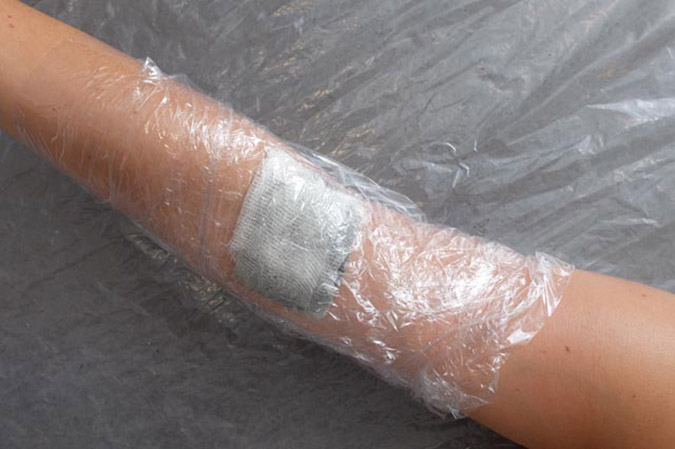
Credit: www.PrimalSurvivor.net/charcoal-poultice License: CC BY 2.0
One benefit of using a poultice to draw out infection is that it is very localized, primarily affecting the area of application. Another is that it allows for prolonged contact with the medicinal plant components.
Tinctures and essential oils are more concentrated than poultices, but they also absorb very quickly, spreading around the whole body. Poultices are longer lasting and much more targeted.
You May Also Enjoy:
Understanding how to make a poultice has another advantage in that poultices typically have a lot of drawing power.1)Bone, Kerry, and Simon Mills. Principles and Practice of Phytotherapy. Churchill Livingston, 2013. This makes them popular treatment choices for objects stuck in the skin, venomous bites, stings, and contact poisons, such as poison ivy.
Are you ready to become a pro poulticer? Then read on to learn the tips, tricks, and techniques to get the most out of this powerful herbal application.
How to Make a Poultice
To make a standard poultice, mix dried or fresh herbs with water, stir or mash into a paste, and apply to the skin. Wrap it all up with a cloth or bandage to hold everything in place. Then congratulate yourself on a job well done.
“That’s awfully vague,” you may be saying. Well, yes, I suppose it is. But learning how to make a drawing poultice is a simple thing when you get down to it.
They’re basically just a paste of herbs and water held against the skin. Rest assured, I will get into more details below. In the meantime, check out this short video for a demonstration:
Consistency
How much water do you mix with your herbs? Well, it’s more of an art than a science. You can find different recommendations for proportions all over the Internet, but it more or less boils down to using the “Goldilocks method.”
This poultice is too dry. Wait, this poultice is too wet. Ahh, this poultice is just right.
The drier you make it, the better it stays in place. The wetter you make it, the better it conforms to your body and the better the herbal constituents will interact with or absorb into your skin. You want it wet enough to spread easily, but firm enough to keep it from running.
If you’ve added too much water, add some more of the herb. If you’ve added too much herb, add some more water.
Fresh or Powdered Herbs?
Use either. Powdered herbs are easier to work with, but fresh herbs are more potent (at least theoretically).
Fresh herbs will require much less water but will require a lot of grinding and mashing with your mortar and pestle. (Or you can just stick them in a blender.)
How to Use a Poultice
When applying a drawing poultice, you’ll usually want to cover about twice the size of the affected area.
You May Also Enjoy:
“Pharmaceuticals vs. Herbal Medicine: 3 Vital Differences”
How to Make Your Own Tinctures, Salves, and Essential Oils
“Case Study: Head Wound Healing of Tissue Defects Using Herbs”
Again, this may vary. Size may not be very crucial when dealing with a splinter. But if I had a rattlesnake bite on my foot, you’d better believe I’d make a whopping big poultice. No point in taking chances.
(By the way, making a large poultice is exactly what Marjory did when she got bitten by a copperhead snake. She wrote about it in her book Snakebite! How I Successfully Treated a Venomous Snakebite at Home; The 5 Essential Preparations You Need to Have.)
The bottom line is that making a bigger poultice isn’t going to hurt anything, but making a smaller one may prove ineffective. When in doubt, go bigger.
That goes for thickness too. You can often get away with thinner poultices for minor things, but somewhere around the size of a thick hamburger patty (or veggie burger) would be ideal.
Duration and Frequency of Use
How long should you leave on a poultice to draw out infection? How often should you apply a new one? Again, you can get all manner of answers from herb books and websites.
For typical applications, an overnight poultice is a good choice. This is based on my theory that it’s a lot easier to deal with a poultice when you’re not walking around doing stuff. Repeat as needed.
You May Also Enjoy:
“19 Remarkable Benefits of Stinging Nettle”
“Oatstraw Benefits: Stress Reliever, Love Potion, Brain Booster, and More”
Of course, poultices can be worn during the day too. A good general rule is 6 hours on and 6 hours off. You could also do anywhere from 4 hours on and 4 off to 12 on and 12 off.2)Jones, Patrick, DVM. The HomeGrown Herbalist. HomeGrown Herbalist, LLC, 2015. I like to give the skin at least half of the day free from the poultice to breath and relax.
Poultice Removal
Poultices usually come off without much trouble. However, if you have a particularly sensitive area or just want to hedge your bets, you could apply a thin layer of oil to the area before applying the poultice.
What If It Won’t Stay Put?
Are your herbs sliding around? Try placing a gauze pad or folded washcloth on top of the herbs before wrapping it all up. Now, when the outer wrapping is bumped or jostled, the herbs will have an extra layer of insulation to keep them from moving.
Fastening Options
While you’re practicing how to make a poultice, remember: It doesn’t have to be fancy. A roll of duct tape works just as well as an ACE elastic wrap to hold it on.
Often, you can wrap the area with a towel, and fasten it by tucking it back in on itself. No additional fastener is needed.
You May Also Enjoy:
“Calendula: Lymph Mover, Detoxifier, Cancer Fighter, and Skin Beautifier”
“10 Medicinal Uses for Comfrey: Wound Healer, Muscle Relaxer, Ulcer Treatment, Eyewash, and More”
That being said, sometimes getting a little fancy can be fun too. Consider sewing a pocket into your poulticing cloth to hold those herbs in place. Another option is to sew hook-and-loop straps to your cloth.
You’ll appreciate this if you ever have to poultice your own arm. One-handed poultices can be tricky.
Super-Charged Poultices
Instead of mixing your plants with water, why not use an herbal tea or a decoction?3)Decoction: A preparation in herbal medicine in which the medicinal components of a plant are extracted through boiling or simmering in water for an extended time. This method is often used with tougher plant parts, such as roots, twigs, or bark. A decoction is similar to an infusion, but uses more heat over a longer period of time.
The benefit of using a decoction or an infusion instead of plain water is that you’ll pack twice the power into the same-size package.
Should Your Poultice Be Hot or Cold?
Temperature can influence your poultice’s effect. A hot poultice will have more drawing power and will stimulate relaxation and blood flow. A cold poultice will help reduce inflammation and dull pain.
If you’re applying a hot poultice, add a layer of plastic wrap directly over the herbs to reduce the amount of heat lost to the air. Reduced airflow also reduces cooling from evaporation.
Fomentation: A Case for Hot
Technically speaking, fomentations aren’t really poultices. They’re more like a close cousin.
Rather than applying herbs to the skin and wrapping them with a towel, a fomentation soaks the cloth directly in an herbal tea or decoction and then applies that cloth to the skin. Wrap this in a warm towel, changing as needed to keep up the heat.
You may want to add a layer of plastic wrap between the two fabric layers to keep your fomentation from soaking up into the outer layer. Heating packs can also be used, if desired.
Herbal Ice: A Case for Cold
Let’s not forget the power of ice. It cools, soothes, and reduces swelling. But why stop with plain old ice? Let’s get some herbs in there.
Caution: With any of these options, a layer of cloth between your skin and the ice is advisable to prevent any damage from the cold.
First, a note of practicality. While you absolutely can make a regular poultice and freeze it, I recommend that you make it much thinner than normal. A thin application is easier to bend, even while frozen, and is safer if you plan to leave it on for an extended time.
You May Also Enjoy:
“Equisetum Hyemale (Horsetail): The BEST Plant for Tooth Health + 8 More Benefits!”
“Our 13 Favorite Books About Herbal Medicine”
“How to Make an Electuary: 13+ Tips for Making Delicious Herbal Medicines”
Another option is freezing plant juice in ice cube trays. If you don’t have a juicer, you can use your blender and strain out the pulp.
Wrap a cube or two of frozen juice in a wash cloth and hold it on the affected area as you would with regular ice. You can also crush the ice with a hammer or blender and wrap it on your arm as a frosty poultice. It feels a bit like having a snow cone wrapped around your arm.
If you don’t have any frozen juice, you can also soak a cloth in fresh juice and stick it in the freezer for a few minutes. You might call this a reverse-fomentation. Be sure you take the cloth out before it freezes.
How to Make a Poultice for Weird Locations
Sometimes, an area does not lend itself to an easy poultice to draw out infection. This may mean some creative wrapping, or in more challenging cases, you may need additional strategies.
Consistency (Part 2)
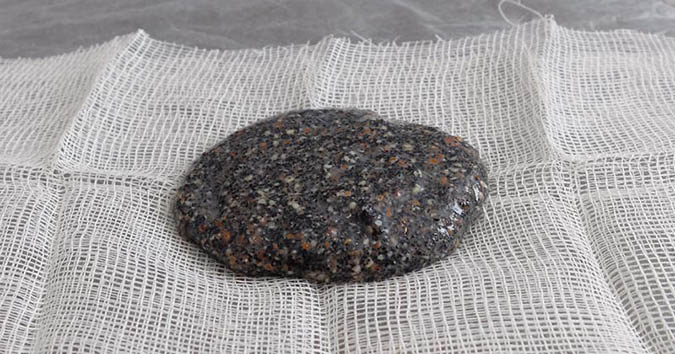
Credit: www.PrimalSurvivor.net/charcoal-poultice License: CC BY 2.0
Altering the amount of liquid in a poultice can often get it to behave the way you want. A wetter poultice will flow in between cracks and crevices to touch every bit of skin. It also penetrates hairy areas better than a thick poultice. The downside is that it tends to be messy and get into a lot of areas you weren’t intending to treat.
A thicker poultice is much easier to keep in place. Knowing how to make a drawing poultice of this sort is especially useful in difficult-to-bandage areas, where a normal poultice would tend to fall away from the skin. The downsides to a thicker mixture are that it tends to crumble if too dry, and the herbal constituents may not absorb into the skin as well.
Poulticing the Ear
The insides of ears can be tricky when using a poultice. You really don’t want little pieces of plant material lost down in the ear canal. That’s just asking for trouble. However, you do have options.
You can cover the opening of the ear with a thin fabric to prevent plant materials from falling in. Then apply a hot poultice to the ear and cover to retain heat. The heat will carry any vaporizing constituents through the air and into the ear. This tends to be most effective with highly aromatic plants.
The classic example is to take an onion slice, heat it up, place it directly over the ear, and cover it with a towel. In this case, no fabric is needed to cover the opening to the ear canal.
Poulticing the Mouth
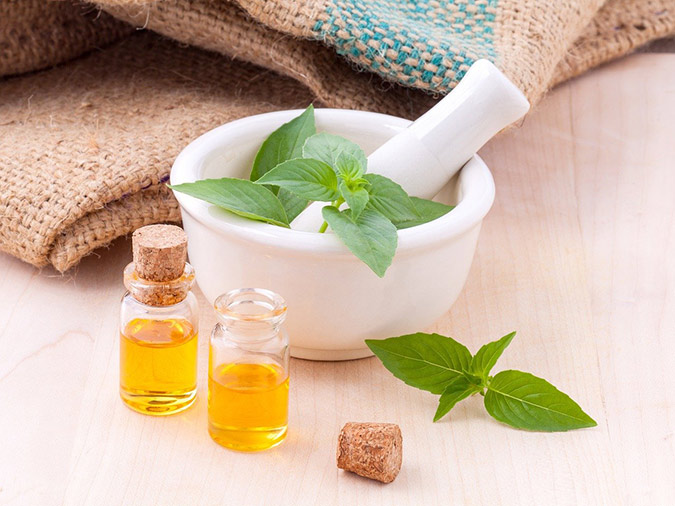
Image by Seksak Kerdkanno from Pixabay
You can’t exactly wrap up the inside of your mouth. But you can pack herbs between your teeth and cheek or directly onto a tooth. This is usually done overnight, since it won’t get in the way of talking and eating.
Be aware that some herbs will stain your teeth. I once used plantain in my mouth to help resolve a blocked salivary duct. It was effective but gave me “zombie teeth” for a few days.
If you’re concerned about staining, a grape leaf can be used to shield your teeth from direct contact.
A poultice can also be applied on the outside of the mouth if tenderness or other factors prevent you from placing herbs inside.
Special Applications
Spit Poultice
You won’t get to use your fun herbalist toys, but spit poultices are often just as effective as anything you’d get from a fancy apothecary. Think of it as a field-expedient poultice.
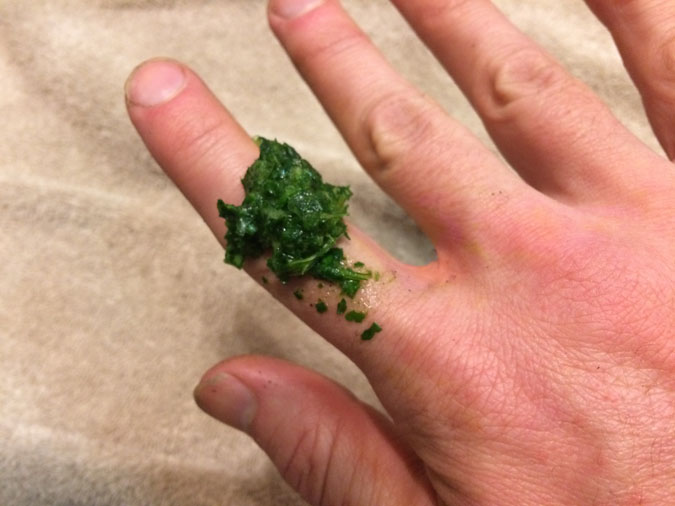
To make a spit poultice, take the plant material and chew it up thoroughly in your mouth, mixing it with your saliva. This may sound gross, but saliva speeds wound healing4)Federation of American Societies for Experimental Biology. “Licking Your Wounds: Scientists Isolate Compound In Human Saliva That Speeds Wound Healing.” ScienceDaily. www.sciencedaily.com/releases/2008/07/080723094841.htm (accessed April 30, 2018). and has antimicrobial properties.5)Tenovuo, Jorma. “Antimicrobial Agents in Saliva—Protection for the Whole Body.” Journal of Dental Research 81, no. 12 (December 1, 2002): 807-009. Accessed April 30, 2018. https://doi.org/10.1177/154405910208101202. Still, you’d rather touch your own spit than someone else’s, right? So let the poultice’s recipient do the chewing.
Apply the plant material, spit and all, to the desired area. If you don’t have anything to wrap it with, you might take a strip of cloth from your shirt, use a clean handkerchief, or just hold it in place until you can find something better.
If you have the right plants around and a little crafty know-how, you can create a wrapping from leaves.
Adhesive Bandages
If your affected area is small enough, a simple adhesive bandage makes a super-easy poultice wrapping. It also works well to hold a thin slice of plant material in place or to cover an area without fully wrapping it up.
I used this method with a stubbornly infected cut on my thumb. I used a thin slice of garlic and a Band-Aid to poultice the cut overnight. In the morning, my thumb joint was a little stiff from the intensity of the garlic, but the infection was 100 percent dead.
Indirect Application
Some herbs can be over-stimulating to bare skin. In these cases, you can lessen the effect by first covering the area with a few layers of cheesecloth or a thin, clean dish towel. Then apply the poultice normally. This slows down the skin’s interaction with the herb, reducing any zingy sensations.
Beauty Treatment
We’ve all seen pictures of someone at a spa. Maybe you’ve been that person. You’ve seen the clay masks on faces and cucumber slices on eyes. Well, those are basically poultices without any fancy wrapping. You now have my permission to go to a spa and tell your family that you’ve got an appointment at a holistic treatment facility.
What Do You Think?
This wraps up my discussion of how to make a poultice. (See what I did there? Because you wrap a poultice around you? No? Nothing? Alright.)
Do you have any special techniques for using a poultice to draw out infection? Maybe a favorite poultice formula? Share them with us in the comments below, and help us power up those poultices.
_______________________________________________________
This is an updated version of an article that was originally published May 23, 2018. The author may not currently be available to respond to comments; however, we encourage our Community members to chime in to share their experiences and answer questions!
Psst! Our Lawyer Wants You to Read This Big, Bad Medical Disclaimer –> The contents of this article, made available via The Grow Network (TGN), are for informational purposes only and do not constitute medical advice; the Content is not intended to be a substitute for professional medical advice, diagnosis, or treatment. Always seek the advice of a qualified health care provider with any questions you may have regarding a medical condition. If you think you may be suffering from any medical condition, you should seek immediate medical attention. You should never delay seeking medical advice, disregard medical advice, or discontinue medical treatment because of information provided by TGN. Reliance on any information provided by this article is solely at your own risk. And, of course, never eat a wild plant without first checking with a local expert.
The Grow Network is a participant in the Amazon Services LLC Associates Program, an affiliate program designed to provide a means for our team to earn fees for recommending our favorite products! We may earn a small commission, at no additional cost to you, should you purchase an item after clicking one of our links. Thanks for supporting TGN!

Scott Sexton is a TGN Trailblazer, a highly experimental gardener, an unrelenting weed-eater, and a largely non-profit herbalist (much to his wife’s chagrin). When Scott is not teaching foraging classes, testing out theories in the garden, or grazing in the forest, he can be found at his Facebook page, “A Forager’s Guide to the Zombie Apocalypse.”
References
| ↑1 | Bone, Kerry, and Simon Mills. Principles and Practice of Phytotherapy. Churchill Livingston, 2013. |
|---|---|
| ↑2 | Jones, Patrick, DVM. The HomeGrown Herbalist. HomeGrown Herbalist, LLC, 2015. |
| ↑3 | Decoction: A preparation in herbal medicine in which the medicinal components of a plant are extracted through boiling or simmering in water for an extended time. |
| ↑4 | Federation of American Societies for Experimental Biology. “Licking Your Wounds: Scientists Isolate Compound In Human Saliva That Speeds Wound Healing.” ScienceDaily. www.sciencedaily.com/releases/2008/07/080723094841.htm (accessed April 30, 2018). |
| ↑5 | Tenovuo, Jorma. “Antimicrobial Agents in Saliva—Protection for the Whole Body.” Journal of Dental Research 81, no. 12 (December 1, 2002): 807-009. Accessed April 30, 2018. https://doi.org/10.1177/154405910208101202. |
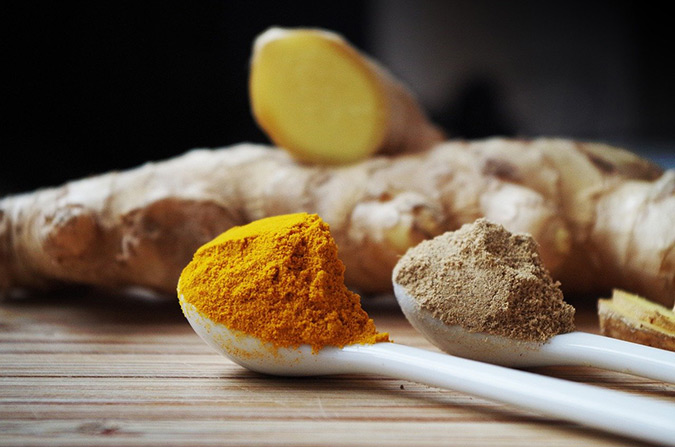
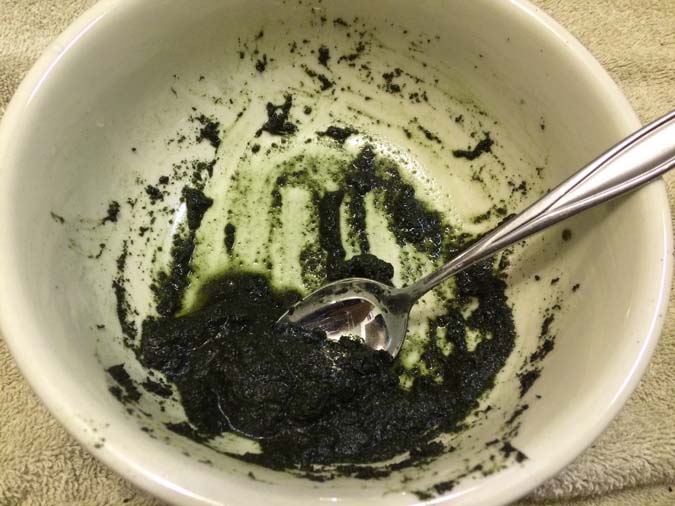
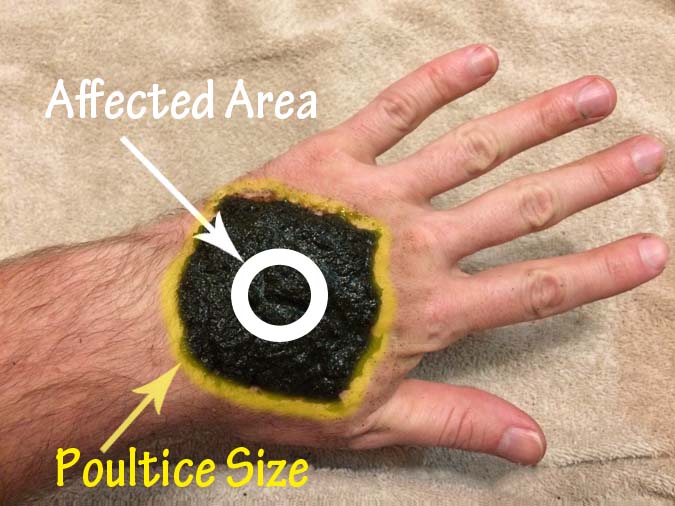
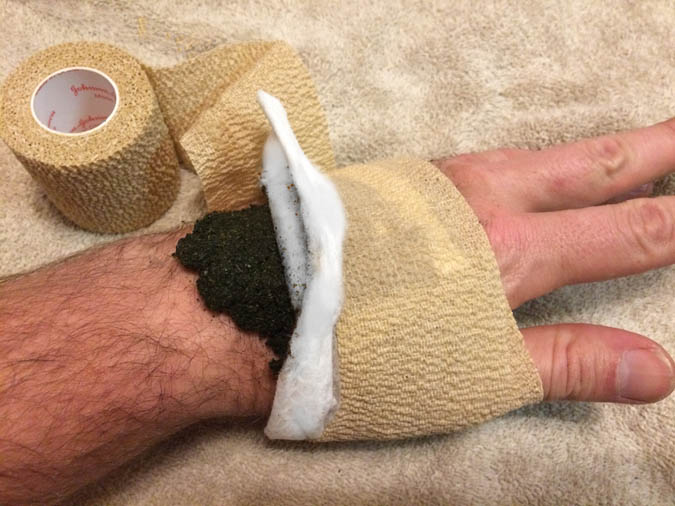
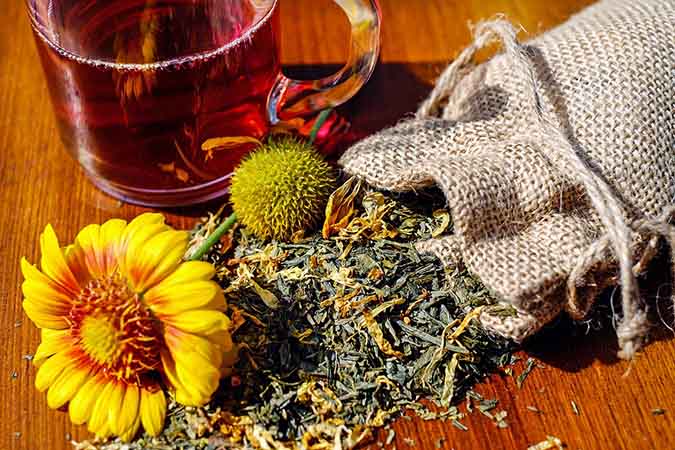
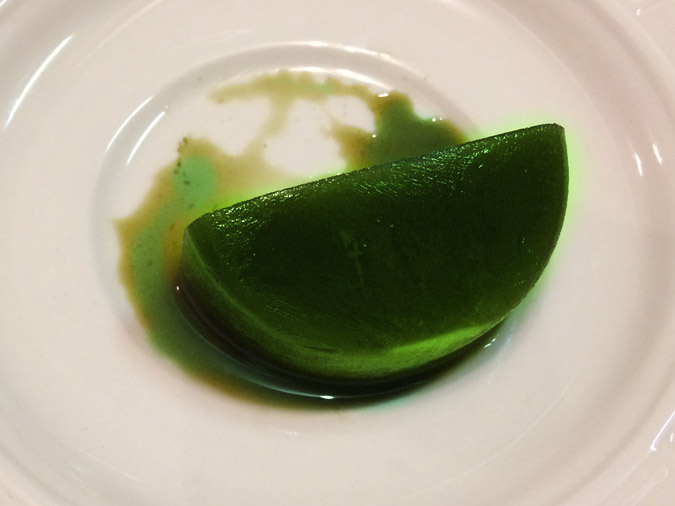
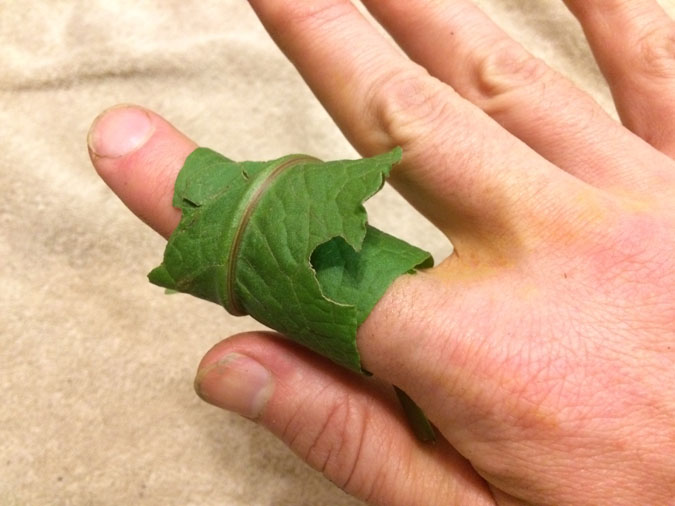
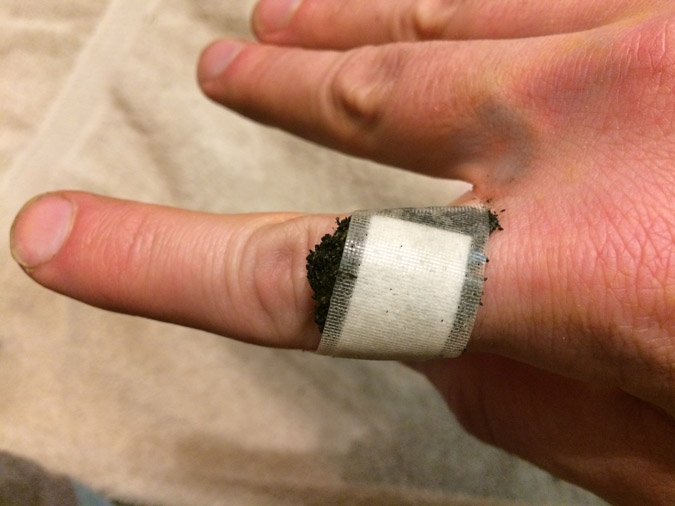
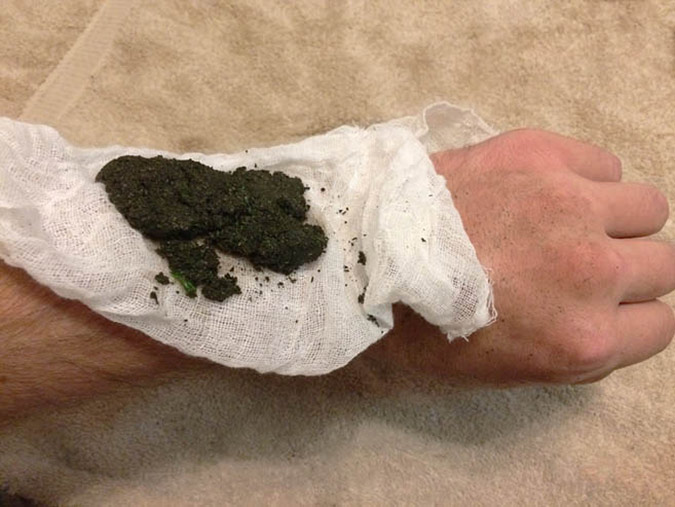
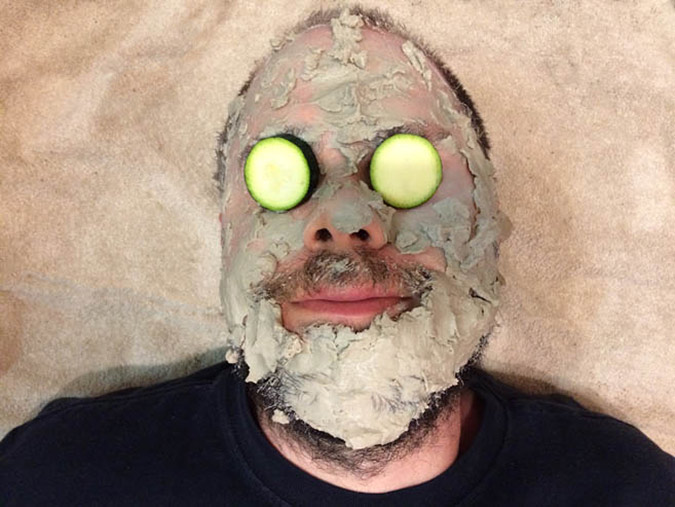







COMMENTS(6)
Hi Scott,
I LOVE poulticing! I’ve healed some of the most bad-ass injuries using them.
It’s amazing medicine.
You did a great job with the video and it’s a really good article.
Well thanks so much! And I know you have. I’ve got your book. 😉
VET TAPE! You even have a photo of the kind made for humans (second photo in this article) yet it wasn’t mentioned in the text… undoubtedly a simple oversight, yet still worthy of followup here since it’s magic. It sticks to itself but not your skin, it doesn’t irritate skin like ordinary bandaids or duct tape (yikes!) — nor does it rip out hair when removed, or sag or fall off like an Ace bandage often will. And vet tape is usually reusable if you are careful not to let it come in contact with anything other than a clean bandage over the poultice underneath. Designed for animals and wrapping wounds over their fur or feathers, it really does work beautifully to hold even heavy poultices in place.
As I read this article tonight I already had a poultice on my left foot to treat my arthritic toes that occasionally flair up, so here’s an example: slap on the poultice (for arthritis I use a charcoal, bentonite clay, and psyllium powder but that’s just me), wrap the entire blob of whatever poultice in a clean strip of damp potato sack cloth, wrap the vet tape completely around the cloth to hold the poultice and cloth in place, and then finish by putting on an oversized old cotton sock (to protect your bed sheets). Sleep. In the morning, remove everything while saving the vet tape if it’s still clean and hadn’t touched the poultice or bare skin, and finish by soaking your feet with an epson salt foot bath to clean any remaining poultice fragments off. Simple! Works like a charm for me, thanks to vet tape.
Vet tape aside, thank you for this wonderful article Scott! Very informative and I hadn’t thought of using herb tea instead of plain filtered water in poultices. Brilliant, I’ll try experimenting with that in the near future. Thanks again!
You’re absolutely right. That tape is awesome stuff. And as you mentioned, socks are a great foot poultice accessory too. If I remember correctly, Marjory used one with her snake bite.
I like your formula. That ought to make for a good poultice. Psyllium, by the way, comes from the plantago genus. I use it a lot. It’s very drawing and is just a great plant for poulticing.
Thanks reading and commenting! 🙂
Doug Simons shows in his video how to use prickly pear (or nopales) for a poultice in the mouth.
Doug is an excellent resource!